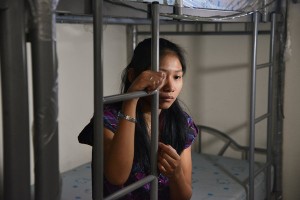Behind Closed Doors, Abuse of Domestic Workers
By KIM BARKER
October 9, 2014
With his latest project, photographer Steve McCurry, best known for his work in war-torn countries like Afghanistan, has documented the suffering of women from Indonesia, Nepal and the Philippines who endured a myriad of abuses while working for families elsewhere in Asia and the Middle East.
“They’re at the complete mercy of these people who see them almost like slaves: ‘You’re my property, you’ll do what I say,’” Mr. McCurry, 64, said. “They go home, and they’re disfigured, and they don’t have money, and they’re psychologically scarred. They end up coming home humiliated, and it becomes like a stigma. In a way, their lives are ruined.”
It is not necessarily a new story. A Malaysian couple was recently sentenced to be hanged for murdering their Indonesian maid by starving her, the latest in a series of headline-grabbing outrages. Responding to horrific treatment in countries like Saudi Arabia, the International Labor Organization, or ILO, a branch of the United Nations, passed a treaty to protect domestic workers in 2011.
Yet the abuses continue, and only 14 countries have ratified the treaty.
Mr. McCurry has always had an eye for portraits, for the survivors who make it through war. His best-known picture, known simply as “Afghan girl,” is of a 12-year-old Afghan girl with green eyes staring straight at the camera, published by National Geographic in 1985.
These new photos are unsettling. In several, the young women show their scars. One Indonesian woman displays her naked back, with purple scars that look something like wings, from boiling water poured on her in Malaysia. A Nepali woman cradles her pregnant belly, the proof of her rape while working in the Middle East — and how she was jailed for adultery afterward.
Some women stare straight at the camera, but not with the defiance shown by other subjects of Mr. McCurry. Instead, their eyes show pain, and almost beg viewers to pay attention to what happened. Mr. McCurry described taking such a portrait as a collaboration with his subject.
“I think the best way to actually photograph somebody is to really look into their eyes,” he said. “The eyes are so expressive, they say so much about a person … I find it more direct and more simple and more honest to shoot people looking straight into my lens.”
Mr. McCurry, who has spent about 35 years in Asia, came to this project through Karen Emmons, 54, a Bangkok-based journalist who became interested in the abuse of domestic workers about seven years ago, while researching an ILO report in Indonesia. After winning a small grant from the ILO, she enlisted Mr. McCurry to take the photographs, hoping that his skill and stature could win more attention for the women.
They visited shelters in Hong Kong and women back in the Philippines, Indonesia and Nepal, spending a week in each place. Ms. Emmons paved the way for Mr. McCurry at each stop, working with local aid groups to find women willing to be photographed.
Ms. Emmons said she was after scars.
“I had trouble getting to people to begin with, as soon as I said I’m looking for people with scars,” she admitted. “Some thought it would traumatize the women. Some thought it was just sensational. I said, ‘It’s important you show the evidence. You can’t just talk about it. People can’t just hear about it, they have to see it.’”
If a woman was willing, Ms. Emmons spent an hour or two talking to her before introducing Mr. McCurry. She said she was wary of potential pitfalls, of bringing a male photographer into take sometimes deeply personal pictures.
Some women had been disowned by their families. One was in hiding. And one woman — Ms. Emmons said she counted more than 30 scars on her — married a man after she came home. He also came to the photo shoot.
Mr. McCurry said that they also often had advocates at the photo shoots to talk to the women.
“We wanted to tell them that this terrible evil act had to be exposed, just for humanity’s sake,” Mr. McCurry said. “And then I think if you’ve been wronged like that, you just want people to know that this act happened, and that you were the victim.”
Article taken from: http://mobile.nytimes.com/blogs/lens/2014/10/09/behind-closed-doors-abuse-of-domestic-workers/?smid=fb-nytimes&smtyp=cur&bicmp=AD&bicmlukp=WT.mc_id&bicmst=1409232722000&bicmet=1419773522000
View all posts in
Posted on 10 Oct 2014

Help FDWs avoid debt
Anisya can help with the MOM paperwork

Found a suitable worker on Anisya? We can help with the MOM paperwork. Our service fee is $450. Click here for more info.
Full service hiring available

Need to hire an FDW in a hurry? Let Anisya help you with screening, short-listing and scheduling interviews with workers, and managing all the MOM paperwork formalities! More details here.
Anisya Web Services works in partnership with Anisya LLP (MOM License 12C5866) for MOM related transactions.
Anisya is a proud Social Enterprise member of the Singapore Centre for Social Enterprise (raiSE) and the Business For Good community which promotes the use of business for social impact.

